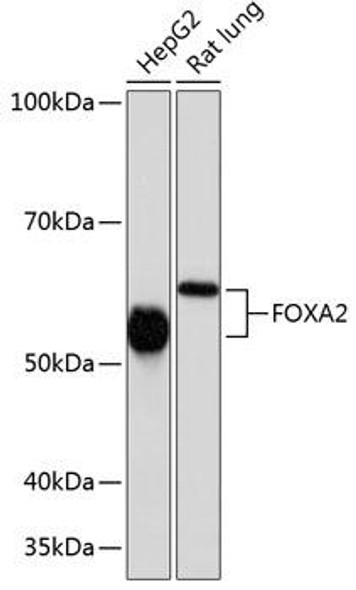Epigenetics & Nuclear Signaling Antibodies 3
Anti-FOXA2 Antibody (CAB17353)
- SKU:
- CAB17353
- Product Type:
- Antibody
- Reactivity:
- Human
- Host Species:
- Rabbit
- Isotype:
- IgG
- Antibody Type:
- Polyclonal Antibody
- Research Area:
- Epigenetics and Nuclear Signaling
Description
| Antibody Name: | Anti-FOXA2 Antibody |
| Antibody SKU: | CAB17353 |
| Antibody Size: | 20uL, 50uL, 100uL |
| Application: | WB |
| Reactivity: | Human |
| Host Species: | Rabbit |
| Immunogen: | Recombinant protein of human FOXA2 |
| Application: | WB |
| Recommended Dilution: | WB 1:500 - 1:2000 |
| Reactivity: | Human |
| Positive Samples: |
| Immunogen: | Recombinant protein of human FOXA2 |
| Purification Method: | Affinity purification |
| Storage Buffer: | Store at -20'C. Avoid freeze / thaw cycles. Buffer: PBS with 0.02% sodium azide, 50% glycerol, pH7.3. |
| Isotype: | IgG |
| Sequence: | Email for sequence |
| Gene ID: | 3170 |
| Uniprot: | Q9Y261 |
| Cellular Location: | Cytoplasm, Nucleus |
| Calculated MW: | 48kDa |
| Observed MW: | Refer to figures |
| Synonyms: | FOXA2, HNF3B, TCF3B |
| Background: | This gene encodes a member of the forkhead class of DNA-binding proteins. These hepatocyte nuclear factors are transcriptional activators for liver-specific genes such as albumin and transthyretin, and they also interact with chromatin. Similar family members in mice have roles in the regulation of metabolism and in the differentiation of the pancreas and liver. This gene has been linked to sporadic cases of maturity-onset diabetes of the young. Transcript variants encoding different isoforms have been identified for this gene. |
| UniProt Protein Function: | FOXA2: Transcription factor that is involved in embryonic development, establishment of tissue-specific gene expression and regulation of gene expression in differentiated tissues. Is thought to act as a 'pioneer' factor opening the compacted chromatin for other proteins through interactions with nucleosomal core histones and thereby replacing linker histones at target enhancer and/or promoter sites. Binds DNA with the consensus sequence 5'-[AC]A[AT]T[AG]TT[GT][AG][CT]T[CT]-3'. In embryonic development is required for notochord formation. Involved in the development of multiple endoderm-derived organ systems such as the liver, pancreas and lungs; FOXA1 and FOXA2 seem to have at least in part redundant roles. Originally discribed as a transcription activator for a number of liver genes such as AFP, albumin, tyrosine aminotransferase, PEPCK, etc. Interacts with the cis-acting regulatory regions of these genes. Involved in glucose homeostasis; regulates the expression of genes important for glucose sensing in pancreatic beta-cells and glucose homeostasis. Involved in regulation of fat metabolism. Binds to fibrinogen beta promoter and is involved in IL6-induced fibrinogen beta transcriptional activation. Binds DNA as a monomer. Binds TLE1. Interacts with FOXA1 and FOXA3. Interacts with PRKDC. 2 isoforms of the human protein are produced by alternative splicing. |
| UniProt Protein Details: | Protein type:Transcription factor; DNA-binding Chromosomal Location of Human Ortholog: 20p11 Cellular Component: cell junction; nucleoplasm; nucleus Molecular Function:DNA binding; transcription factor activity Biological Process: adult locomotory behavior; cell fate specification; endocrine pancreas development; negative regulation of glucokinase activity; negative regulation of transcription factor activity; negative regulation of transcription from RNA polymerase II promoter by glucose; positive regulation of embryonic development; positive regulation of transcription from RNA polymerase II promoter; positive regulation of transcription from RNA polymerase II promoter by glucose; positive regulation of transcription, DNA-dependent; regulation of blood coagulation; regulation of transcription from RNA polymerase II promoter |
| NCBI Summary: | This gene encodes a member of the forkhead class of DNA-binding proteins. These hepatocyte nuclear factors are transcriptional activators for liver-specific genes such as albumin and transthyretin, and they also interact with chromatin. Similar family members in mice have roles in the regulation of metabolism and in the differentiation of the pancreas and liver. This gene has been linked to sporadic cases of maturity-onset diabetes of the young. Transcript variants encoding different isoforms have been identified for this gene. [provided by RefSeq, Oct 2008] |
| UniProt Code: | Q9Y261 |
| NCBI GenInfo Identifier: | 8134491 |
| NCBI Gene ID: | 3170 |
| NCBI Accession: | Q9Y261.1 |
| UniProt Secondary Accession: | Q9Y261,Q8WUW4, Q96DF7, |
| UniProt Related Accession: | Q9Y261 |
| Molecular Weight: | 48,907 Da |
| NCBI Full Name: | Hepatocyte nuclear factor 3-beta |
| NCBI Synonym Full Names: | forkhead box A2 |
| NCBI Official Symbol: | FOXA2 |
| NCBI Official Synonym Symbols: | HNF3B; TCF3B |
| NCBI Protein Information: | hepatocyte nuclear factor 3-beta |
| UniProt Protein Name: | Hepatocyte nuclear factor 3-beta |
| UniProt Synonym Protein Names: | Forkhead box protein A2; Transcription factor 3B; TCF-3B |
| Protein Family: | Forkhead box protein |
| UniProt Gene Name: | FOXA2 |
| UniProt Entry Name: | FOXA2_HUMAN |






